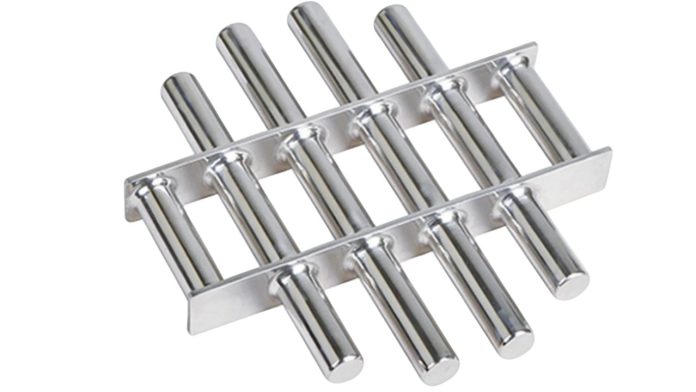Grate magnets are essential tools in various industries, designed to remove ferrous metal contaminants from materials during production processes. By using powerful magnetic fields, they ensure that only clean, contaminant-free materials proceed down the line, protecting equipment and improving product quality. In this article, we’ll explore how grate magnets work, their types, and the key benefits they offer for industrial applications.
Magnetic grates are specialized magnetic separators designed to remove ferrous contaminants from materials during production processes. These contaminants, often in the form of metal particles, can pose serious risks to both the quality of the product and the functionality of equipment further down the production line. Grate magnets consist of a series of magnetic rods or bars arranged in a grid-like formation, creating a barrier through which materials flow. As materials pass through, these magnets attract and capture metal debris, ensuring that only clean, contaminant-free material proceeds through the process.
- Tube Magnets: These consist of individual magnetic tubes arranged to form a grate-like structure, commonly used for smaller particle removal.
- Magnetic Grids: A more extensive arrangement, magnetic grids use multiple rods to create a grid that is typically installed in hoppers, chutes, or bins.
- Magnetic Bars: These bars are similar to tubes but are typically solid, offering a more robust magnetic field for capturing larger metal contaminants.
- Stainless Steel: Often used for the housing of grate magnets, stainless steel offers excellent durability and resistance to corrosion, ensuring the magnets remain effective in harsh industrial environments.
- Rare Earth Magnets: These magnets, such as neodymium, offer a stronger magnetic field than traditional ferrite magnets, making them particularly effective in capturing even the smallest metal particles.
Grate magnets operate on the principle of magnetic separation. When materials move through a production process, they pass through a series of magnetic rods or bars. These rods generate a magnetic field that attracts and holds ferrous metal contaminants—such as iron or steel particles— that might be present in the material stream. The structure and design of the grate magnets allow for efficient removal by creating multiple points where metal can be captured, ensuring that contaminants are separated from the material without disrupting the flow.
The principle behind magnetic separation relies on the different magnetic properties of materials. Ferrous metals are attracted to magnets, while non-ferrous materials, such as plastics or wood, are not affected by the magnetic field. This allows grate magnets to selectively remove metal contaminants without interfering with the rest of the material.
Grate magnets are typically installed in locations where materials flow through a conveyor, hopper, or chute. The grid or bar configuration increases the surface area for metal capture, ensuring even small particles are trapped. The design is highly effective at removing even fine ferrous contaminants , thus safeguarding downstream equipment and improving product quality.
Grate magnets offer several key advantages in industrial applications. Their efficient metal removal capabilities help improve product quality, protect equipment, and reduce maintenance costs. Below are some of the primary benefits that make grate magnets essential for many production processes.
Efficiency in Removing Metal Contaminants : Grate magnets are highly effective at removing ferrous debris, improving material purity and preventing damage to machinery.
Protection of Sensitive Equipment : By removing metal particles before they reach sensitive machinery or equipment, grate magnets help prevent costly breakdowns and repairs.
Enhanced Product Quality and Safety : Clean materials free from metal contaminants result in higher-quality end products, ensuring safety and satisfaction for consumers.
Easy Installation and Maintenance : Grate magnets are simple to install in existing production lines and are designed for easy cleaning and maintenance, reducing downtime and operational disruptions.
Grate magnets play a crucial role in industrial applications by ensuring that metal contaminants are removed from materials during processing. Their ability to effectively capture ferrous particles improves product quality, protects equipment, and boosts operational efficiency. Whether used in recycling, food processing, or other industries, grate magnets are an essential tool for maintaining the integrity of products and machinery, making them indispensable in modern production lines.













